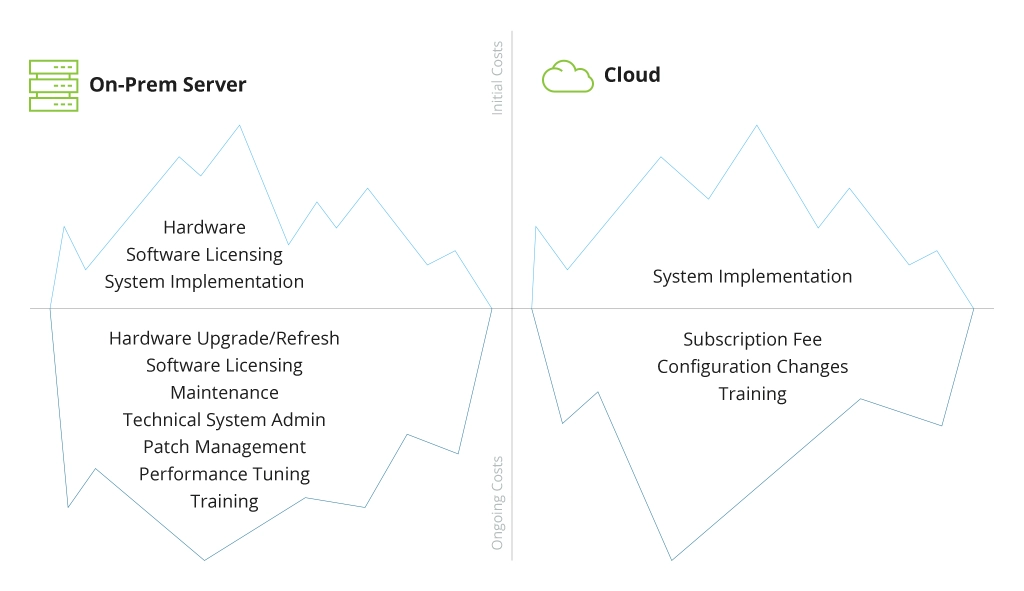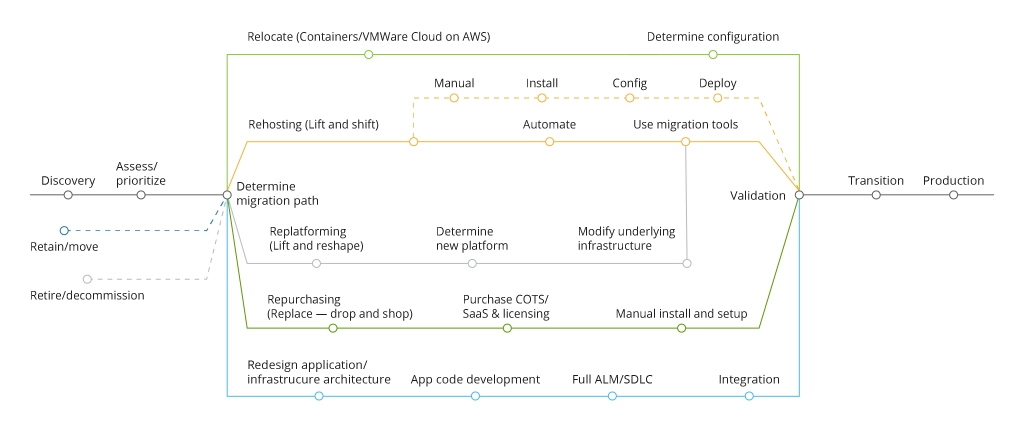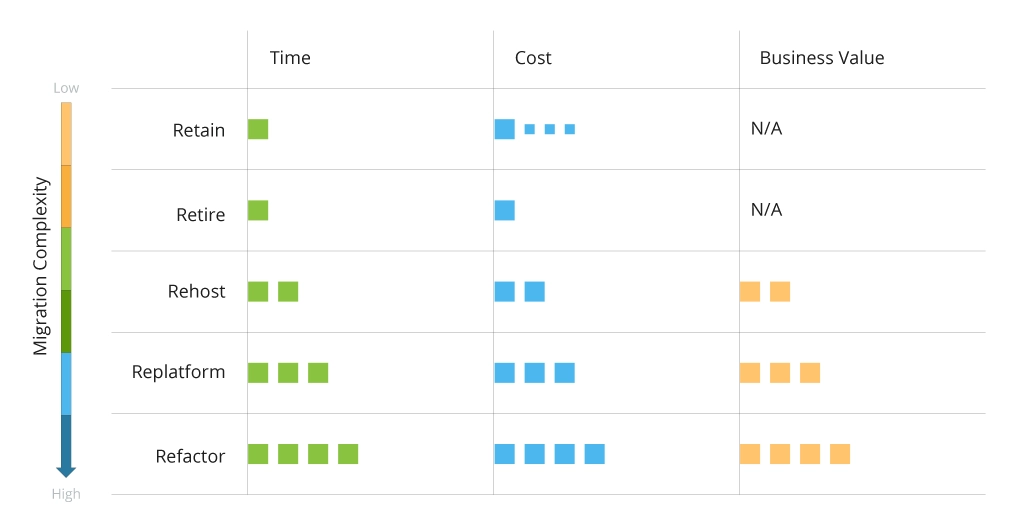5 Application Migration Strategies and How to Make Them Work
Yet, there are numerous approaches to performing app migration. Each one serves a specific purpose and has its benefits and challenges. In this article, we will analyze the main strategies of the application migration services to understand which one to choose depending on the migration purpose. We will also uncover the potential challenges of app migration and the solutions to address them effectively.
What Is Application Migration?
Application migration is the process of porting software, related data structures, and other IT resources to a new environment. You might, for instance, migrate an application from one on-premises data center and server to another, more powerful physical infrastructure. Due to the COVID-19 impact and the need to adopt the Anywhere Operation Model, most companies apply for application migration from on-premises data centers to a cloud. A few types of cloud are used:
- Public cloud: public cloud environment gives access to applications, data, and other IT resources over the internet without the need to maintain any hardware. Public cloud resources are shared between multiple tenants on a subscription or pay-per-user basis.
- Private cloud: it is used by a single tenant for personal use by one company. It provides higher security and control over the on-premises IT ecosystem than public clouds.
- Hybrid cloud: it is a mix of on-premises, public, and private environments. For instance, with this type of cloud, confidential data and other critical resources are kept in a private cloud. At the same time, a public one is used for analytics services. Hybrid clouds help save costs while maintaining the required security level for the enterprise's IT ecosystem.
- Multi-cloud: it is a set of multiple clouds from different vendors connected into one architecture to form a single user experience. It gives the flexibility to operate in the best environment for specific needs. Check out our post where we compare multi-cloud vs. hybrid cloud. To get better view of different multi-cloud architectures, read our recent post about cloud native and cloud agnostic approaches.
A recent report from IMIR states that the cloud migration market is projected to grow from $7.25 billion in 2021 to $29.64 billion by 2028, growing at a CAGR of 22.48%. Enterprises are modernizing their apps to improve security, reduce costs, and strengthen business continuity. The need for a more advanced operating environment to support those needs drives the increase in application migration services popularity and, respectively, the cloud migration market growth.
Reasons for Application Migration
Organizations decide to move their software to a new environment to resolve technical issues, scale, modernize applications, adopt innovations, and drive business growth. Here are the key drivers of performing the application migration.
1. Poor app performance
The main reason for moving the application to a new environment is their low performance and inability to support additional users. Inefficient application resources impact productivity and customer performance. Within the growing user base, applications require other resources to process the increasing requests, manage growing amounts of data on time, and eliminate breakages on peak loads.
To address these challenges, most enterprises choose migration to a cloud. Cloud is a more flexible structure and less expensive to scale than building new resources on-site.
Infopulse delivered such an application migration service to Ukraine's most prominent pharmaceutical producer, Darnytsia, as part of the company's digital transformation project. Migration to a modern cloud environment brought the company tangible business benefits, including improved communication with internal and external users, better data security management, and reduced licensing, technical support, and maintenance costs.
2. Compliance
Applications may require migration due to compliance reasons. For example, if the organization does not have proper cybersecurity and threat monitoring infrastructure on-premises, migration to a cloud with the secure customer data processing in place would be the right solution. Organizations must meet the regulations applicable to their industry, including GDPR, ISO standards, HIPAA, PCI DSS, and others. With evolving legislation and new regulations appearing, adjusting the on-premises IT infrastructure around applications gets more complicated and resource-consuming. To ensure compliance with the newest industry-related standards, businesses can use Compliance Aspekte, a 360 Governance, Risk, and Compliance management solution. It helps automate compliance activities, cross-implement controls for several standards based on your specific regulatory requirements, and simplify reporting routine among the rest.
3. Security
The cybersecurity capabilities of modern clouds are non-comparable to those of traditional on-premises infrastructures. Cloud vendors provide robust security systems to protect data centers, adhering to recognized data protection standards. With advanced cloud cybersecurity solutions, legacy applications can gain a significantly higher information security, a critical demand for most commercial organizations dealing with customer data. See how the Infopulse team significantly improved IT infrastructure security for one of the leading telecom service providers in Ukraine. We migrated the legacy infrastructure to a cloud and enabled modern cybersecurity tools on Azure cloud. As a result, our client significantly increased business efficiency due to the implemented Microsoft 365 and 24/7 employee access to Digital Workplace and all corporate resources. The upgraded enterprise infrastructure now operates with minimized potential cybersecurity risks and effective user access management. We also managed to reduce maintenance costs by repurposing outdated hardware.
4. Cost Efficiency
Supporting and maintaining legacy applications is often significantly more expensive than migrating them to a cloud with all its automation tools. While migrating to a cloud initially requires more expenses, it later results in considerably lower TCO.
TCO of On-Premises and Cloud Applications
Moving to the cloud over on-premises infrastructure means eliminating all hardware-related expenses and decreasing costs for personnel and operations. Explore how to optimize the cost of cloud resources to gain maximum cost-efficiency after moving to the cloud infrastructure.
5. Flexibility
Businesses are highly dynamic in the change of their performance and operational demands. To address those changes, the companies must scale their hardware, software, and workforce investments. On-premises infrastructures that host business applications are significantly less flexible and riskier in terms of ROI. On the contrary, application migration to the cloud allows for scaling up or down the resources. They can be changed dynamically in response to any changes in business needs. It helps save both time and money while providing all necessary infrastructure changes compared to the same improvements of an on-premises environment.
Automated allocation of all required resources, adaptive auto-scaling, technological flexibility, cost-efficiency, and extended capabilities to adopt innovations are the key value factors of the application migration to a cloud. Organizations can maximize the business value of migrating their software to a new environment with the right strategy. Infopulse’s managed infrastructure services are aimed to help companies transform their IT infrastructures to optimize operational costs and boost business productivity with appropriate migration strategies and the type of cloud infrastructure relevant to the enterprise’s demands. Initial transition and further 24/7 infrastructure maintenance help maximize the business value of moving to the cloud.
Application Migration Strategies
Software is typically built on a specific operating system in a particular network architecture that can cause specific challenges for its migration. Moving applications from virtualized architectures is generally easier than migrating from hardware infrastructure.
Depending on the type of architecture, security and compliance requirements for your enterprise, and available budget, you can choose the appropriate application migration strategy. Here are the primary migration patterns.
Rehost (Lift-and-Shift)
The application is moved from an on-premises hardware server to a cloud platform. This approach implies no significant changes to the app code and configurations, takes less time and cost compared to other methods. Infopulse’s cloud engineers used this approach in our data center migration project for a large international mining and metals company. We migrated the client’s on-premises infrastructure to Microsoft Azure cloud. This transition allowed the company to continue implementing its digital transformation strategy towards adopting innovative IT services, scale up the digital infrastructure as per the business growth needs, enhance data security and privacy, and reduce operational support costs.
Yet, rehosting implies certain limitations due to the application's inherent cloud compatibility that should be considered in each specific case. Internal and external dependencies may limit the ability to embrace advanced capabilities, as many cloud-native features are unavailable with a rehost strategy.
Refactor (Re-architect)
This application migration type is also called 'rip and replace'. It involves reworking the app architecture or code to make it compatible with cloud-native benefits. Sometimes it implies significant recoding, building additional features, and scalability advancements. The most critical risk here is how such changes may affect the performance of others and the overall software ecosystem of the enterprise.
Re-platform
This method is in the middle between rehosting and refactoring and involves minor changes to the application code to embrace the benefits of cloud architecture. For instance, re-platforming may require upgrades to work with a cloud-native managed database, changing the operating system or middleware, or containerization. It is an ideal choice for apps that do not require more significant modifications to make them run effectively in the cloud, with all the security and performance benefits the new environment provides.
Retire (Repurchase)
Not all legacy applications can be adjusted for migration with adequate time and cost investments. Sometimes it makes more sense to simply retire the old application and replace it with alternative cloud-based software or Software-as-a-Service (SaaS) tools. The other use case for the retirement approach is when the app value is limited due to duplication of its capabilities elsewhere in your environment.
Infopulse applied this approach for a cloud digital transformation of a Europe-leading pharmaceutical distributor. We built a modern hybrid Exchange Online Infrastructure on Microsoft Azure and migrated a local mailing server to Microsoft Office 365. Moving to a cutting-edge cloud infrastructure with further ongoing support and maintenance helped our client to increase business productivity, streamline its operations, improve cross-communication and collaboration between users, and strengthen the company’s overall data security and integrity.
Retain
It literally means 'doing nothing' for now. When enterprises decide to migrate to a cloud, some applications of their ecosystem may not impose enough value to perform their migration. To optimize the migration costs, you should focus on migrating the resources that make sense for the business. Other applications can be just retained and 'revisited' later. Comparing the application migration methods from above, you should take into account their time-cost-value ratio.
Comparing Cloud Migration Strategies
Besides the technical specifics, you should consider unique business needs, technical requirements, and plans for future application advancements to design a successful migration scenario and modernize legacy software without interrupting any business operations.
Key Challenges During Application Migration
Besides the limitations of specific migration strategies, enterprises face certain general challenges when deciding to migrate to a new environment. They can be addressed effectively with recommendations from our application migration experts.
Uncertain Cost of the Cloud Migration Process
Challenge: The total cost of the application migration includes the cloud infrastructure costs, data migration costs, direct and indirect costs for app maintenance, and post-migration expenses for app integration and testing. The budget should include workforce and training fees and other less obvious cost items. Companies often fail to estimate the financial impact beforehand and incur unexpectedly high migration expenses.
Solution: The best way to avoid extra expenses for the app migration is to prepare. You can apply to an application migration service from a trusted provider and request to set out the project budget before committing to a migration plan. It is also helpful to consider a few providers and compare their offerings to choose the most appropriate cost plan.
Technical Difficulties
Challenge: Application migration can be a substantial technical undertaking. The exact complexity involved will depend on the migration project size, the nature of migrated software, its interconnection with other components of the digital ecosystem, the type of cloud infrastructure involved (public, private, hybrid, multi-cloud), and the business needs behind the migration.
Solution: You can hire specialists to help outline the correct migration plan and resolve technical issues. Otherwise, you can upskill your in-house team to manage the technical complexity of the migration project.
Potential for Business Disruption
Challenge: The migration of business-critical applications like SAP or Oracle may cause operational interruptions and financial losses due to service outages. If migrations are performed online, the network capacity may be strained and disrupt the performance of other workloads. The migration of production workloads also can run past the planned outage time, which may put end users at extra losses. All these potential risks must be analyzed and managed to ensure business continuity and consistency.
Solution: Providers of application migration services offer the right combination of in-depth cloud expertise and migration toolset to ensure business continuity during migration. The experts also help you plan every aspect of the project and adequately document the work scope and resources for its execution. Focus on service providers offering data redundancy and failover environments to minimize risks of any unexpected interruptions in business operations. The impact of migration is also minimized with the automated tools for workload discovery and mapping, DNS transfers, and data formatting.
Case in point: Infopulse performed seamless infrastructure migration for a Nordic logistics and supply chain company. We ensured 24/7 AWS operations service with 99.99% infrastructure availability.
Data Security and Compliance Risks
Challenge: Data security concerns remain a significant barrier to migrating to a cloud. Many organizations do not trust handling confidential data with third-party security vendors. They need to be more confident that cloud environments guarantee the required privacy and security and are uncertain of compliance regulations adherence. The SANS 2022 survey shows that security still remains the biggest concern in the cloud due to a number of factors:
- Unauthorized application components (54%)
- Poorly configured interfaces and APIs (52%)
- Inability to respond to incidents (51%)
- Unauthorized access by outsiders (51%).
How can that uncertainty be eliminated?
Solution: Modern cloud platforms utilize industry-grade security systems to establish a holistic cloud environment. A belief that on-premises storage is more secure compared to a cloud is one of the most popular myths about data migration. The application migration tools in the cloud ensure the transferred data is passed through a preferred routable path, with the firewall guarding safe transfer. This process ensures private information is masked from third parties during migration. The overall security in cloud systems is governed by recognized data protection standards, guaranteeing meeting compliance regulations for applications operating in the cloud. At the same time, enterprises are responsible for secure cloud architecture. Appropriate firewalls, strong passwords, and other tools must be activated on the client side to maintain the security demands. Therefore, you need a reliable cloud services vendor and a solid in-house security policy in action to ensure a fruitful migration strategy.
Final Thoughts
Application migration helps enterprises modernize their IT infrastructure to enable app advancements and customer experience improvements. It also helps address numerous security and compliance challenges and build the ground base for business scaling. Depending on the application type and operation specificity, you can choose the suitable approach from five key application migration strategies:
- Rehost
- Refactor
- Re-platform
- Retire
- Retain.
Cloud migration technology is flexible in its realization, which makes it applicable to any industry and business type. Many companies experience various challenges when planning and executing such migrations. Applying for application migration services from a proven provider helps simplify that process and, in most cases, significantly reduces the costs required for project completion.
Infopulse helps enterprises to experience the best cloud infrastructure with our cloud services and performs seamless cloud migration for applications to numerous platforms, including Microsoft Azure, Google Cloud Platform, Amazon Web Services, Oracle Cloud Infrastructure, and others. Our experts are ready to consult you regarding the best suitable solution for your business needs and help with cloud architecture design and software migrations. We also provide post-migration cloud support to ensure stable infrastructure performance and scalability for smooth growth.
![Application Migration Strategies [banner]](https://www.infopulse.com/uploads/media/banner-1920x528-5-application-migration-strategies-and-how-to-make-them-work_1.webp)






![Power Apps Licensing Guide [thumbnail]](/uploads/media/thumbnail-280x222-power-apps-licensing-guide.webp)
![Cloud-Native for Banking [thumbnail]](/uploads/media/cloud-native-solutions-for-banking_280x222.webp)
![Generative AI and Power BI [thumbnail]](/uploads/media/thumbnail-280x222-generative-AI-and-Power-BI-a-powerful.webp)
![AI for Risk Assessment in Insurance [thumbnail]](/uploads/media/aI-enabled-risk-assessment_280x222.webp)
![How to Build Enterprise Software Systems [thumbnail]](/uploads/media/thumbnail-280x222-how-to-build-enterprise-software-systems.webp)
![Super Apps Review [thumbnail]](/uploads/media/thumbnail-280x222-introducing-Super-App-a-Better-Approach-to-All-in-One-Experience.webp)
![ServiceNow and Third-Party Integrations [thumbnail]](/uploads/media/thumbnail-280x222-how-to-integrate-service-now-and-third-party-systems.webp)
![SAP Service Insight [thumbnail]](/uploads/media/Service Insight-Infopulse-SAP-Vendor-280x222.webp)
![Carbon Management Challenges and Solutions [thumbnail]](/uploads/media/thumbnail-280x222-carbon-management-3-challenges-and-solutions-to-prepare-for-a-sustainable-future.webp)
![White-label Mobile Banking App [Thumbnail]](/uploads/media/thumbnail-280x222-white-label-mobile-banking-application.webp)